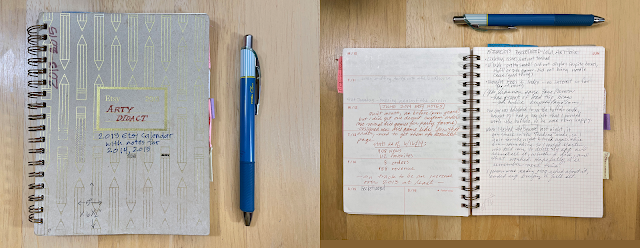When I decided to not make a planner this year, I started looking for alternatives that met the criteria I set for myself, inspired by one that Etsy gave out to its sellers years ago, as I related in my planners part one post, here.
That is, I wanted a planner that is fairly small, with a simple unfussy format, and that's flexible in how you can use it, because I use it more as a log or record book than for planning. I want it to lay flat when opened so it's easy to write in or even keep open on your desk if you want to do that.
Some of the ones that meet that criteria are undated, which, on the one hand, is nice because you could start it any time, and it certainly makes sense for the seller, because they never become obsolete! But it's not as useful to you and me because you need to consult a calendar to fill in the dates and note whichever holidays are relevant to you.
In fact, when it occurred to me that if you have to fill in the calendar part of a planner yourself, you could use any notebook that is the size and quality you like, if you just had a printable version of a current calendar, such as the 2025 Useful Calendar, to paste or tape into it. So I made the medium size version of the desk calendar into a printable PDF for anyone who wants to do that.
Here's my very short list of planners you might want to consider, if you're still looking for a planner.
Field Notes
The undated 56-week planner by Field Notes is the one I bought for my husband, who will use it as a kind of log book.
It has a sturdy chipboard cover, a spiral binding, and a nice clean design. It's the smallest of all those I found, at 4.75" x 7.5". It's also very economical at $16.95.
It has only weekly spreads, no full month pages like most other planners. That seems like a drawback if you're looking ahead, but not a problem for a log book or diary.
Nuts and Bolts Paper Co.
I also ordered another one that's undated (on the inside) from a shop called Nuts and Bolts Paper Co., which is really about baby books and other mom stuff, but I was intrigued by the look of their planner, so I ordered one. The cover color choices were just mint or pink, and being more of an earth-tone kind of person, I wasn't crazy about either, but I ordered pink. The base price is $12; with the addition of pockets it came to $18.
Minnesota Weatherguide Environment Calendar
 |
| Mementos pasted into the back of my 2023 Weatherguide calendar |
 |
| An index in the back of my 2023 Weatherguide calendar. |
Other planners that might work for you
I didn't buy any more planners to review, because, you know, I can only buy so many! But here are a couple more that looked appealing. Maybe one of them is just what you were looking for.This Etsy shop has a very nice basic planner, with natural brown chipboard covers, spiral binding, and a straightforward layout that doesn't add fussy trendy things like goal trackers and such. It's about 6" x 8", has major holidays noted on the month spreads, and weekly pages that follow. There are two pockets as a folded insert (at the front), and a set of sticker tabs to apply yourself. The 178 pages includes 14 pages for notes.
Frankly, this comes the closest to what I was looking for, other than being a little larger than I'd want, but I discovered it after I had bought the foregoing, and I wasn't going to buy any more of them!
Fringe Studio
This company has several attractive planners, two of which are dated and the others undated. The covers feature lovely artwork and they appear to be well constructed, although I did not examine any of them "in person," so that's just a general impression. They come in a wide variety of types, covers, and sizes, with prices ranging from $15 to $40. Worth browsing through, anyway, even if only to look at all the cover designs.
... or there's always the DIY spreadsheet ...
Finally, a confession: For actual planning, like to-do lists and weekly schedules and such, I use a spreadsheet on my computer. I note the weather forecast at the top because it affects whether I plan to go someplace by bicycle or stay home or drive somewhere, and since the weather is constantly changing, so are my plans. My to-do lists are often unrealistic, so I regularly copy-and-paste items to another day. I can color code the rows and boxes and then change them frequently, and I have a row or two across the bottom for vague sometime-in-the-future tasks that I don't want to completely forget about.
Other than those future-task rows, all the entries are constantly changing and ephemeral, so if I want to note that I completed a given task, I write it down somewhere else, like in a planner/log book!
I made my weekly planner with the Numbers application that comes with Apple devices, which I can then access on my computer or iPad. But I'm sure you could do something like this in any spreadsheet program. (Another confession: the "House cleaning" row is purely aspirational. I rarely do any of the things.)
Here's what it looks like as of today (in two screen shots):
Good luck and happy planning in the new year!










